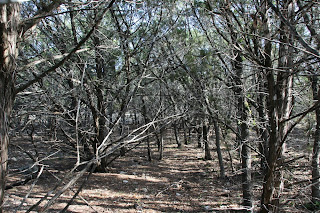However, land that has been taken care of with good stewardship practices is beautiful because it is balanced and the needs of humans, native animals, and plants are all taken into account.
There are open spaces with beautiful grasses and wildflowers, wooded areas with a mixture of evergreen and deciduous trees and shrubs, and water, either in creeks or in man made lakes.
Our Hill Country Land Stewardship Workshop is described as "A day on the Ranch with emphasis on "Stewardship" for the large or small landowner or anyone considering buying land, who wants to know how to improve land for all plant and animal species. Transportation is on the Bluebonnet. This eight hour, out-door workshop will be conducted by our experienced ranch personnel. You will look at and examine the many projects that demonstrate the principles that have been successfully used on this ranch. The subjects include:
"Cedar-management: clearing second growth cedar, selecting cedar to keep, and maintaining cleared areas free of re-growth cedar. Tools to use. Erosion control and re-vegetation of cleared land.
 A cedar thicket is difficult to walk through, has little to no grass on the ground. However, leaving some thicket as a refuge for wildlife is important.
A cedar thicket is difficult to walk through, has little to no grass on the ground. However, leaving some thicket as a refuge for wildlife is important. Workshop attendees try their hand at cutting small small cedars using lopping shears. (Photograph by Dudley Harris)
Workshop attendees try their hand at cutting small small cedars using lopping shears. (Photograph by Dudley Harris) Leroy Petri the man who designed and created the spring fed, gravity flow water system here at Selah talks about spring development at one of our unboxed springs. (Photograph by Dudley Harris)
Leroy Petri the man who designed and created the spring fed, gravity flow water system here at Selah talks about spring development at one of our unboxed springs. (Photograph by Dudley Harris) Madrone Lake was constructed in 1988 and has never dried up completely, though we have seen it down as much as 6 feet from its level when full.
Madrone Lake was constructed in 1988 and has never dried up completely, though we have seen it down as much as 6 feet from its level when full."Tree planting: because of the threat of oak wilt we don't know the future of oaks in Texas. It is important to plant a diversity of trees to provide shade and habitat for the future. Learn planting techniques and tree care. We have secrets you need to know.
 J. David demonstrates the proper way to plant a tree in the Hill Country. (Photograph by Dudley Harris)
J. David demonstrates the proper way to plant a tree in the Hill Country. (Photograph by Dudley Harris)"Managing land for wildlife: elements of good wildlife habitat, census taking and proper balance with domestic livestock, furnishing supplemental water and feed for deer and non-game species.
 Whitetail deer are plentiful in the Hill Country and managing their numbers is important for land health, as well as for the deer's health. (Photograph by SH)
Whitetail deer are plentiful in the Hill Country and managing their numbers is important for land health, as well as for the deer's health. (Photograph by SH) The African Scimitar-horned Oryx is the subject of the Species Survival Program that we participate in. Selah is one of the places that provides them with a large amount of rangeland.
The African Scimitar-horned Oryx is the subject of the Species Survival Program that we participate in. Selah is one of the places that provides them with a large amount of rangeland. The Golden-cheeked warber is one of the endangered birds that lives here. It needs a combination of old cedars and Spanish Oaks. This photograph was taken in mid-March when they first arrive after wintering south of the border in a warmer climate. (Photograph by Amanda Fulton)
The Golden-cheeked warber is one of the endangered birds that lives here. It needs a combination of old cedars and Spanish Oaks. This photograph was taken in mid-March when they first arrive after wintering south of the border in a warmer climate. (Photograph by Amanda Fulton)Finally, "8-hour workshop includes a short hike, coffee breaks and lunch. Dress for the weather."
The website for the ranch has a list of workshops being given during the next 6 months and a link to the registration form if you'd like to sign up. In our Stewardship Workshops, we also hold one on Water, one on Grasses, and one on Trees and Shrubs, which go into the different aspects of stewardship in much greater depth.
Photographs by Margaret Bamberger unless otherwise noted.




No comments:
Post a Comment